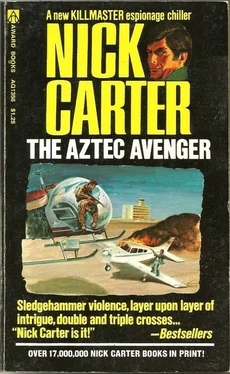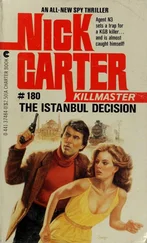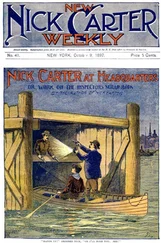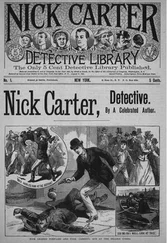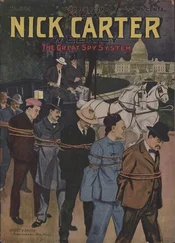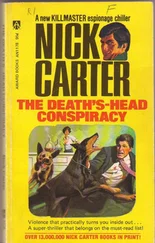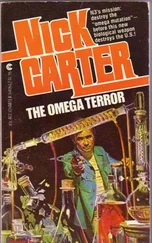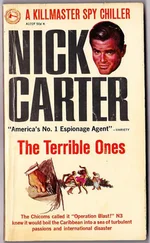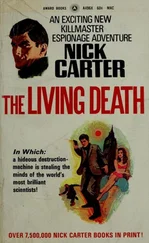Nick Carter - The Aztec Avenger
Здесь есть возможность читать онлайн «Nick Carter - The Aztec Avenger» весь текст электронной книги совершенно бесплатно (целиком полную версию без сокращений). В некоторых случаях можно слушать аудио, скачать через торрент в формате fb2 и присутствует краткое содержание. Год выпуска: 1974, Издательство: Award Books, Жанр: Шпионский детектив, на английском языке. Описание произведения, (предисловие) а так же отзывы посетителей доступны на портале библиотеки ЛибКат.
- Название:The Aztec Avenger
- Автор:
- Издательство:Award Books
- Жанр:
- Год:1974
- ISBN:нет данных
- Рейтинг книги:4 / 5. Голосов: 1
-
Избранное:Добавить в избранное
- Отзывы:
-
Ваша оценка:
- 80
- 1
- 2
- 3
- 4
- 5
The Aztec Avenger: краткое содержание, описание и аннотация
Предлагаем к чтению аннотацию, описание, краткое содержание или предисловие (зависит от того, что написал сам автор книги «The Aztec Avenger»). Если вы не нашли необходимую информацию о книге — напишите в комментариях, мы постараемся отыскать её.
The Aztec Avenger — читать онлайн бесплатно полную книгу (весь текст) целиком
Ниже представлен текст книги, разбитый по страницам. Система сохранения места последней прочитанной страницы, позволяет с удобством читать онлайн бесплатно книгу «The Aztec Avenger», без необходимости каждый раз заново искать на чём Вы остановились. Поставьте закладку, и сможете в любой момент перейти на страницу, на которой закончили чтение.
Интервал:
Закладка:
“Hurry!” Ortega shouted at me.
The police car turned on its siren and its flashing red beacon. A series of shots came from it as it raced down the side road toward us. I heard the thunk of bullets slamming into the side of the heavy sedan. Paco flung open the door and scrambled to the front of the car. He began to fire back at the police cruiser. The big Parabellum bucked in his hand with each shot.
I heard Ken Hobart cry out, but his shout was drowned in the blasting of Paco’s Mauser.
Suddenly, the police car swerved off the road in a long skid, spinning around in a scream of tires, completely out of control, its headlights making revolving arcs in the darkness like a gigantic, whirling St. Catherine’s wheel. Paco stopped firing. I heard the gasping wheeze of Carlos’ breathing.
The silence was almost complete, and in that moment, with the danger gone, Paco fell into a panic. He leaped to his feet and threw himself into the driver’s seat. Before Carlos could grasp what he was doing, Paco had put the sedan into gear and was racing off into the night across the fields as fast as he could push the car.
Carlos shouted at him to come back. “Idiot! Fool! There’s no danger! Where are you going? Come back!”
He stared at the taillights of the car growing smaller every second. Then he shrugged and dropped down off the wing, ducking under it to get to Ken Hobart The lanky, redheaded Englishman lay in a crumpled mess on the ground near the right main landing gear.
Carlos stood up slowly, the gun in his hand held limply by his side, frustration showing in every line of his body.
“He’s dead.” He uttered the words in a tone of quiet resignation. “And that fool has driven off.” He turned away from the body. I dropped off the wing and knelt beside Hobart. The Englishman’s head had fallen against the right tire of the aircraft. His chest was covered with blood that still seeped slowly out of him.
I pulled Hobart as far away from the aircraft as I could. Wiping the blood off my hands with my handkerchief, I walked back to Carlos, who was still standing beside the aircraft. “What’s the matter with you?” I asked him roughly.
Defeat was written into every line of his face. “We’re finished, amigo,” he said dully. “Paco has gone with the car. Hobart is dead. We have no way to escape from this place. How long do you think it will be before there will be more police here?”
“Not before we can be gone. Get in that airplane!” I snarled at him.
Carlos looked up at me blankly.
“Damn it!” I swore at him. “If you’re going to stand there like an idiot, we’ll never get out of here! Now move!”
I scrambled up onto the wing and into the pilot’s seat. Carlos followed me in, slamming the cabin door shut as he settled himself in the seat.
I snapped on the cabin overhead light and scanned the panel quickly. There was no time to go through the complete checklist. I could only hope that Hobart had been right when he’d said that the plane was ready for takeoff, and I prayed that none of the shots fired by the police had struck a vital part of the aircraft.
Almost automatically my hand went out, turning on the master switch, turbo-charger circuit breakers on, turbo switches off. I flicked on the magneto and the electric fuel pumps, then I cracked the throttles about half an inch and pushed the fuel mixture levers to full rich. The fuel flow meters began to register. Back to idle cutoff. I engaged the left-hand starter switch and heard the whining, rising scream of the starter motor.
The left-hand prop swung over once, twice, and then caught with a spitting, cracking roar. Mixture back to full rich again. I fired up the right engine.
No time to check out all the gauges. Time enough only to move elevators, ailerons, rudder, as I fed in power to the twin engines and taxied the aircraft to the runway, turning onto it, trying to line up with its dim outline in the darkness. I turned off the cabin interior light and turned on the landing lights. I set quarter flaps, and then my hands were on the twin throttles, pushing them forward smoothly until they hit the stop. The big turbo-charged Lycomings bellowed as the aircraft began moving forward down the strip, faster and faster.
As the airspeed indicator reached eighty miles an hour, I hauled back on the ram’s horn control wheel. The nose lifted, the pounding of the main gear on the bumpy dirt strip ceased. I snapped off the lights. We were airborne.
I made the rest of the climbout in complete darkness, pulling up the gear lever, hearing the whine and then the heavy thunking of the main gear retracting into their wheel wells. At a hundred twenty miles an hour, I trimmed the aircraft to hold a steady rate of climb.
For the same reason I’d snapped off the landing lights as soon as I’d cleared the ground, I didn’t turn on the red and green running lights or the rotating strobe beacon. I wanted no one on the ground to see the aircraft. We were flying in complete darkness, illegal as hell, with only the faint, blue spitting flames from our exhausts to give away our position and, as I reduced climb power, even those disappeared.
At eighteen hundred feet, I turned the aircraft northwest, keeping the mountains to my right. I turned to Carlos. “Look in the map compartment. See if Hobart has his charts there.”
Ortega pulled out a stack of WAC maps.
“Good,” I said. “And now, if you’ll tell me where we’re going, I’ll try to get us there.”
CHAPTER SEVENTEEN
It was daylight when I reduced power and came down over the mountains to the brown, bare hills somewhere in the area bounded by Durango, Torreen and Matamoros. We were flying now at less than five hundred feet, with Ortega peering out the starboard window, giving directions to me.
I made a landing on a strip to the north of an isolated ranch house. There was only a wooden shack to mark the end of the strip. I taxied the big Aztec twin up to it and killed the engines.
A surly-faced Mexican in worn chino trousers came out of the shack to meet us. He didn’t speak to us as he began to service the aircraft, topping off the tanks and checking the oil.
We all got out of the plane. I spread out the sectional air charts on the wing of the plane and Carlos drew in the route for me to follow, marking the point where we would sneak across the border into the States.
“Here’s where we cross,” he said, pointing to a spot on the Rio Bravo just south of the Texas railroad town of Sierra Blanca. “Beginning here”— he pointed again, this time to a place more than a hundred miles inside Mexico—”you’ll have to fly as low as you can. You cross the river at no more than treetop height, make an immediate turn to go around Sierra Blanca to the north, and then, at this point head northeast.”
“And from there?”
Carlos straightened up. “From there, I’ll direct you again. Remember, minimum altitude until we are well across the border.”
I folded the charts and stacked them in the order I’d use them. The Mexican had finished refueling the aircraft. Doris came back with Susan and the old man. They climbed aboard the aircraft, Susan ignoring me as if I did not exist, Dietrich walking stiffly like a man in a trance. Carlos got in after I did.
He shut and locked the door and fastened his seat-belt. I sat there a moment, rubbing the bristles on my chin, my eyes tired from lack of sleep, my right arm aching.
“Shall we go?” Ortega prodded.
I nodded and started the engines. I swung the big Aztec around into the wind and fed in power as we raced down the dirt field and took off into the crisp, blue Mexican sky.
It takes several hours to fly from Torreon-Durango to the Rio Bravo. I had plenty of time to think and the vague ideas that had begun to form in my mind the evening before — wild, almost impossible thoughts — began to crystallize into a hard suspicion that grew more and more solid with every passing minute.
Читать дальшеИнтервал:
Закладка:
Похожие книги на «The Aztec Avenger»
Представляем Вашему вниманию похожие книги на «The Aztec Avenger» списком для выбора. Мы отобрали схожую по названию и смыслу литературу в надежде предоставить читателям больше вариантов отыскать новые, интересные, ещё непрочитанные произведения.
Обсуждение, отзывы о книге «The Aztec Avenger» и просто собственные мнения читателей. Оставьте ваши комментарии, напишите, что Вы думаете о произведении, его смысле или главных героях. Укажите что конкретно понравилось, а что нет, и почему Вы так считаете.
